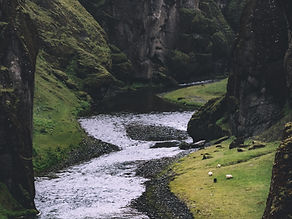
River features: Yes or No?
From mountain to the sea
We have enjoyed our time along the river during our day out, but can you tell which part we were on?
Rivers, vital components of Earth's hydrological cycle, carve diverse landforms as they wind through landscapes. From their mountainous origins to sprawling deltas meeting the sea, rivers sculpt the Earth's surface, creating a dynamic tapestry of landforms. The journey begins with headwaters in elevated terrains, where fast-flowing streams cut through valleys. As rivers meander downstream, they mold the landscape into bends and curves. Ultimately, the journey concludes with the formation of deltas where rivers converge with oceans. Understanding these river landforms provides insight into the complex and interconnected processes that shape the ever-evolving face of the Earth.
Upper Course
-
Source
-
Where the river starts
-
-
Tributaries
-
Where streams meet the river
-
-
Waterfalls
-
Vertical drop of the river
-
-
Gorges
-
Very narrow valley
-

Middle Course
-
Meanders
-
Where river flows in curvy path
-
-
Slip-off slopes
-
Deposition feature on the inner convex bank of the meander
-
-
River cliffs
-
Erosion feature on the outer concave bank of the meander
-

Lower Course
-
Floodplains
-
Flat land alongside the river
-
-
Levées
-
low ridge at the river side that prevent flooding
-


River Features Hunter
With a total length of 31.7km, the Water of Leith stretches from the northwest of the Pentland Hills to Leith. The Walkway along the River, and the associated woods, form the green corridor in Edinburgh. It is an ideal place to observe the river features alongside.
Try to find the closest part of Water of Leith near you home and go for a family walk. While walking along the River, you can try to look closely at the River and spot the features mentioned above. Follow the descriptions and identify which course the part belongs to. Let's see who can come up with a conclusion first! You can always take some photos and compare them to standard sample photos online. Is there any difference between sample photos and reality? If so, why do you think that is? What information can you gather by comparing the two?
Continue walking along the River as you wish. Are there any changes compared to the part before? You can compare the features between different parts of the River. Do they have similar or different river features? Is the course of the rivers the same or different? It is recommended that parents discuss this with their children to reach a conclusion. Notice the changes in river features and try to appreciate the beauty of nature as a whole. The River you are visiting is part of your local environment and it is important to preserve and protect rivers and other natural features to maintain this beautiful green area in your community.

